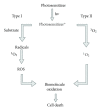Innovative strategies to overcome biofilm resistance
- PMID: 23509680
- PMCID: PMC3591221
- DOI: 10.1155/2013/150653
Innovative strategies to overcome biofilm resistance
Abstract
We review the recent literature concerning the efficiency of antimicrobial photodynamic inactivation toward various microbial species in planktonic and biofilm cultures. The review is mainly focused on biofilm-growing microrganisms because this form of growth poses a threat to chronically infected or immunocompromised patients and is difficult to eradicate from medical devices. We discuss the biofilm formation process and mechanisms of its increased resistance to various antimicrobials. We present, based on data in the literature, strategies for overcoming the problem of biofilm resistance. Factors that have potential for use in increasing the efficiency of the killing of biofilm-forming bacteria include plant extracts, enzymes that disturb the biofilm structure, and other nonenzymatic molecules. We propose combining antimicrobial photodynamic therapy with various antimicrobial and antibiofilm approaches to obtain a synergistic effect to permit efficient microbial growth control at low photosensitizer doses.
Figures


Similar articles
-
Applications of Antimicrobial Photodynamic Therapy against Bacterial Biofilms.Int J Mol Sci. 2022 Mar 16;23(6):3209. doi: 10.3390/ijms23063209. Int J Mol Sci. 2022. PMID: 35328629 Free PMC article. Review.
-
[Activity of antimicrobial agents on bacterial biofilms].Enferm Infecc Microbiol Clin. 2008 Feb;26(2):107-14. doi: 10.1157/13115546. Enferm Infecc Microbiol Clin. 2008. PMID: 18341923 Review. Spanish.
-
In- vitro-activity of additive application of hydrogen peroxide in antimicrobial photodynamic therapy using LED in the blue spectrum against bacteria and biofilm associated with periodontal disease.Photodiagnosis Photodyn Ther. 2019 Jun;26:306-312. doi: 10.1016/j.pdpdt.2019.04.015. Epub 2019 Apr 16. Photodiagnosis Photodyn Ther. 2019. PMID: 31002887
-
Photodynamic antimicrobial chemotherapy (PACT) using toluidine blue inhibits both growth and biofilm formation by Candida krusei.Lasers Med Sci. 2018 Jul;33(5):983-990. doi: 10.1007/s10103-017-2428-y. Epub 2018 Jan 13. Lasers Med Sci. 2018. PMID: 29332258
-
Synergistic antimicrobial effect of photodynamic therapy and ciprofloxacin.J Photochem Photobiol B. 2016 May;158:122-9. doi: 10.1016/j.jphotobiol.2016.02.036. Epub 2016 Mar 2. J Photochem Photobiol B. 2016. PMID: 26971277
Cited by
-
Approaches for Mitigating Microbial Biofilm-Related Drug Resistance: A Focus on Micro- and Nanotechnologies.Molecules. 2021 Mar 26;26(7):1870. doi: 10.3390/molecules26071870. Molecules. 2021. PMID: 33810292 Free PMC article. Review.
-
In vitro model of production of antibodies; a new approach to reveal the presence of key bacteria in polymicrobial environments.BMC Microbiol. 2016 Sep 9;16(1):209. doi: 10.1186/s12866-016-0821-5. BMC Microbiol. 2016. PMID: 27612600 Free PMC article.
-
What an Escherichia coli Mutant Can Teach Us About the Antibacterial Effect of Chlorophyllin.Microorganisms. 2019 Feb 22;7(2):59. doi: 10.3390/microorganisms7020059. Microorganisms. 2019. PMID: 30813305 Free PMC article.
-
Silver Nanocoating Technology in the Prevention of Prosthetic Joint Infection.Materials (Basel). 2016 May 5;9(5):337. doi: 10.3390/ma9050337. Materials (Basel). 2016. PMID: 28773461 Free PMC article. Review.
-
Current Strategies for Combating Biofilm-Forming Pathogens in Clinical Healthcare-Associated Infections.Indian J Microbiol. 2024 Sep;64(3):781-796. doi: 10.1007/s12088-024-01221-w. Epub 2024 Apr 8. Indian J Microbiol. 2024. PMID: 39282194 Review.
References
-
- McDonagh AF. Phototherapy: from ancient Egypt to the new millennium. Journal of Perinatology. 2001;21(supplement 1):S7–S12. - PubMed
-
- Roelandts R. The history of phototherapy: something new under the sun? Journal of the American Academy of Dermatology. 2002;46(6):926–930. - PubMed
-
- Costerton JW, Stewart PS, Greenberg EP. Bacterial biofilms: a common cause of persistent infections. Science. 1999;284(5418):1318–1322. - PubMed
-
- Whitchurch CB, Tolker-Nielsen T, Ragas PC, Mattick JS. Extracellular DNA required for bacterial biofilm formation. Science. 2002;295(5559):p. 1487. - PubMed
Publication types
MeSH terms
Substances
LinkOut - more resources
Full Text Sources
Other Literature Sources
Medical

